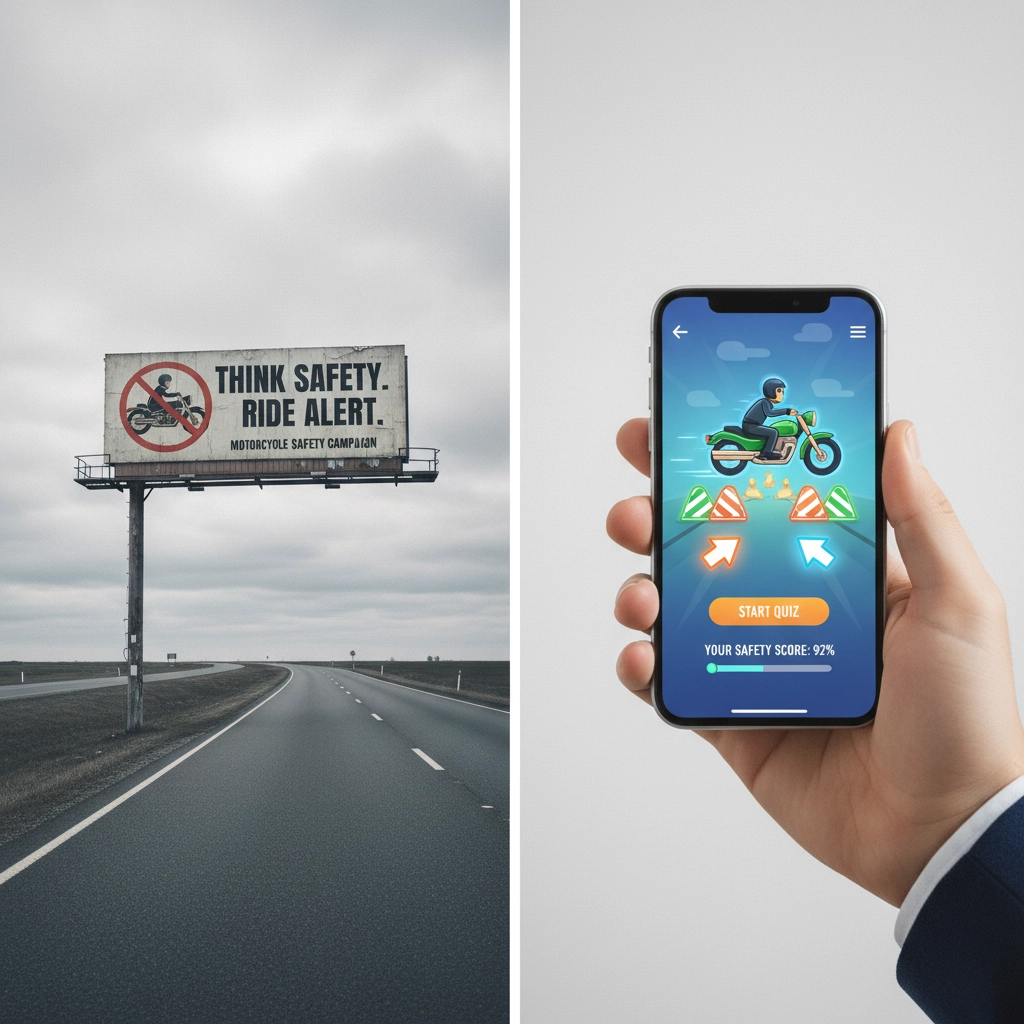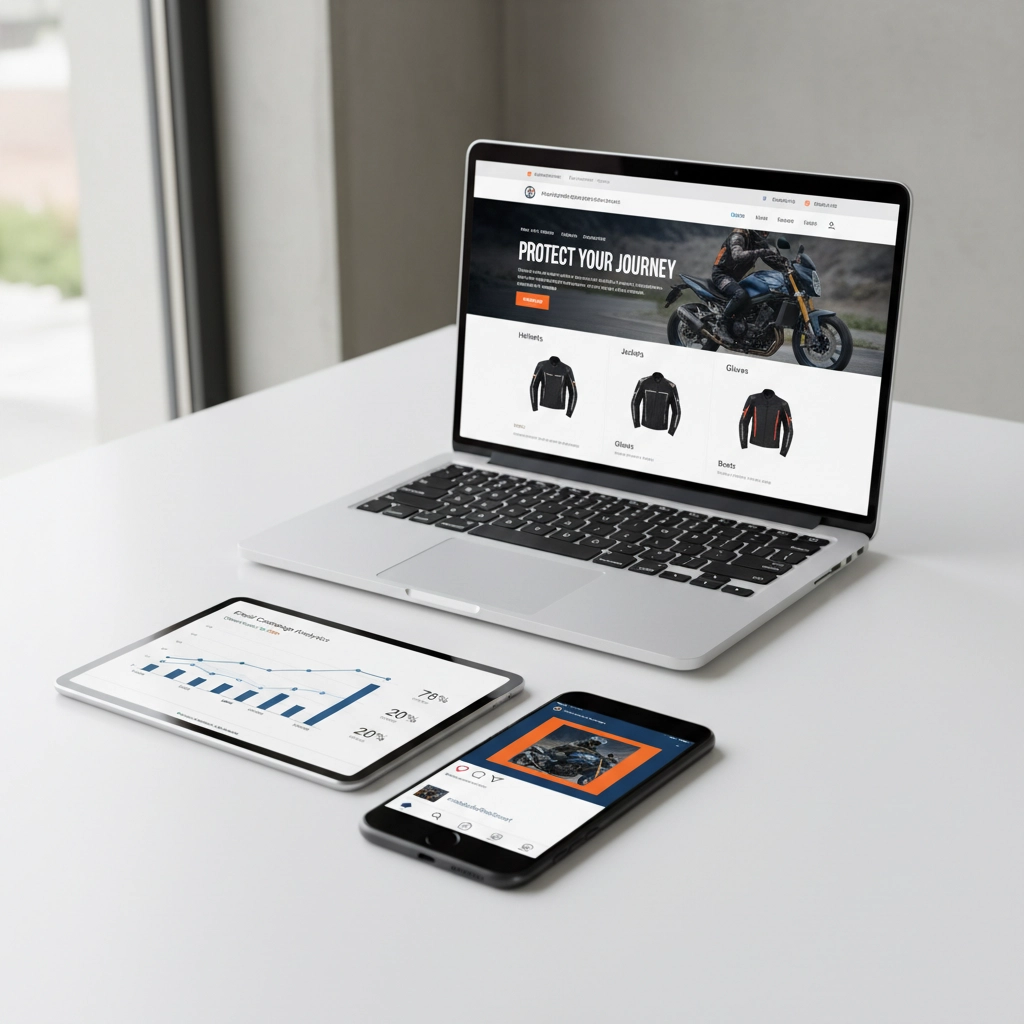Quick Answer: Digital outreach campaigns deliver superior targeting, measurable results, and cost-effectiveness compared to traditional safety campaigns. While traditional methods offer broad reach, digital platforms provide precise geographic targeting, interactive engagement, and real-time analytics. The most effective motorcycle safety initiatives combine both approaches in a coordinated multi-channel strategy that maximizes impact while optimizing resource allocation.
The motorcycle safety landscape has reached a critical crossroads. Traditional awareness campaigns have dominated the field for decades, yet motorcycle fatalities continue to climb. Meanwhile, digital platforms promise precision targeting and measurable outcomes that could revolutionize how we approach rider safety.
If you're responsible for motorcycle safety initiatives, you're probably wondering which approach delivers the best return on investment. The answer isn't as straightforward as you might think, but the data reveals some compelling insights that could reshape your entire strategy.
The Traditional Campaign Conundrum
Motorcycle Safety Awareness Month campaigns have become as predictable as spring weather. Every May, organizations dust off the same "Look Twice, Save a Life" messaging and blast it across television, radio, and billboards. The approach feels comprehensive, but there's a problem no one wants to discuss.
Research reveals a startling truth about traditional motorist awareness programs: there are no peer-reviewed, published evaluations proving their effectiveness. None. After decades of investment in these campaigns, we're operating on assumptions rather than evidence.

The fundamental flaws run deeper than measurement issues. Traditional campaigns operate on two questionable premises: that motorists are unaware of motorcyclists on the road, and that simply telling drivers to "look for motorcycles" will change their behavior. Both assumptions lack scientific support.
Television and radio spots reach broad audiences but struggle with engagement. A 30-second safety message during commercial breaks competes with smartphones, conversations, and countless distractions. The passive nature of traditional media means your carefully crafted message might reach a million people, but how many actually absorb and retain the information?
Print advertisements and billboards face similar challenges. They provide wide exposure but limited interaction. You can measure impressions, but measuring genuine engagement or behavioral change remains nearly impossible with traditional tracking methods.
The Digital Advantage: Precision Meets Performance
Digital outreach transforms motorcycle safety campaigns from broad-stroke awareness efforts into precision-targeted interventions. The capabilities available through digital platforms would have seemed like science fiction just a decade ago.
Geographic precision stands as digital's greatest strength. Instead of blanketing entire metropolitan areas with generic safety messages, digital campaigns can focus on zip codes over-represented in multi-vehicle motorcycle crashes. This targeting extends beyond simple demographics to behavioral patterns and location-based risk factors.
Interactive content changes everything about engagement quality. While traditional media asks audiences to passively consume information, digital platforms encourage active participation. Interactive safety quizzes, virtual reality crash simulations, and gamified learning modules create memorable experiences that stick with users long after they've closed their browsers.

Social media amplification multiplies your message's reach organically. When someone shares your safety content, it carries implicit endorsement from a trusted source. This peer-to-peer validation proves far more powerful than corporate messaging delivered through traditional channels.
Cost-effectiveness makes digital particularly attractive for organizations with limited budgets. Low-cost initiatives can achieve significant impact through paid digital and social media channels, email campaigns, and direct mail integration. The ability to start small, test effectiveness, and scale successful elements provides financial flexibility traditional campaigns can't match.
Measuring What Matters: Analytics Revolution
Traditional campaigns offer frustrating measurement limitations. You can track how many people potentially saw your billboard or heard your radio spot, but determining actual behavior change requires expensive, time-consuming follow-up studies that most organizations can't justify.
Digital analytics provide real-time insights into campaign performance. Click-through rates, engagement time, content sharing patterns, and conversion tracking offer granular understanding of what works and what doesn't. This data enables continuous optimization throughout campaign lifecycles rather than post-mortem analysis months later.
Heat mapping and user journey analysis reveal how people interact with your safety content. Which sections capture attention? Where do visitors lose interest? This intelligence allows for immediate adjustments that improve effectiveness while campaigns are still running.
Geographic data integration takes measurement further by connecting digital engagement with real-world crash data. Organizations can track whether increased digital engagement in specific areas correlates with improved safety outcomes, creating evidence-based validation for continued investment.
The Multi-Channel Reality
The most successful motorcycle safety initiatives don't choose between digital and traditional approaches. They recognize that different audiences consume information through different channels, and effective safety communication requires meeting people where they are.
Coordinated messaging across multiple channels creates frequency and reinforcement that neither approach achieves alone. A motorcyclist might hear your safety message on the radio during their morning commute, see related content on social media during lunch, and receive a targeted email with specific safety tips that evening.
Traditional media excels at reaching older demographics who might not engage heavily with digital platforms. Radio campaigns during peak commuting hours capture attention when drivers are most likely to encounter motorcyclists. Television spots during local news broadcasts reach audiences already focused on community safety issues.

Digital channels complement traditional reach by providing depth, interaction, and measurable engagement. The combination creates a comprehensive safety ecosystem that addresses different learning styles, consumption preferences, and demographic characteristics.
Implementation Strategy: Getting It Right
Budget allocation requires careful consideration of your target audience and available resources. Organizations with limited funding should prioritize digital channels due to their cost-effectiveness and measurement capabilities. Larger budgets can support multi-channel approaches that maximize both reach and engagement.
Start with digital targeting in high-risk geographic areas identified through crash data analysis. Use social media and email campaigns to build engaged communities around motorcycle safety. Supplement with traditional media in markets where digital penetration might be limited or where broad awareness remains important.
Message consistency across all channels ensures reinforcement rather than confusion. Develop core safety themes that translate effectively across different media formats while allowing platform-specific customization for optimal engagement.
Testing and optimization become continuous processes rather than one-time activities. Digital platforms enable A/B testing of different messages, visual approaches, and delivery timing. Use these insights to refine not just digital campaigns but traditional elements as well.
The Verdict: Evidence Points Digital
While traditional campaigns maintain value in specific contexts, digital outreach delivers superior results across most meaningful metrics. The combination of precise targeting, interactive engagement, comprehensive analytics, and cost-effectiveness makes digital the clear choice for resource-constrained organizations seeking maximum impact.
However, the ultimate answer isn't digital versus traditional but rather how to integrate both approaches strategically. The most effective motorcycle safety initiatives use digital precision to identify high-risk areas and audiences, then deploy coordinated multi-channel messaging that meets people where they consume information.
The future of motorcycle safety lies in evidence-based campaigns that prove their effectiveness through measurable outcomes. Digital platforms provide the tools and analytics necessary for this evolution, while traditional media contributes reach and demographic diversity that pure digital approaches might miss.
Your motorcycle safety initiative deserves better than decades-old assumptions and unmeasurable outcomes. The technology and insights exist today to create campaigns that save lives through targeted, engaging, and provably effective communication strategies.
Ready to revolutionize your motorcycle safety campaigns? Visit www.RideFearFree.net to discover how data-driven approaches can transform your safety initiatives. Contact Dan Kost, CEO, at +1 (970) 693-4854 or connect with him on LinkedIn for personalized strategy consultation.
Share this insight: Help other safety professionals discover effective campaign strategies by sharing this post on LinkedIn, Facebook, X, and Instagram.
Tags: #Motivation #Branding #Strategy #Marketing #AdvertisingAndMarketing #DigitalMarketing #Innovation #Sports #MotorcycleSafety #CampaignStrategy #DigitalOutreach #TrafficSafety #DataDriven #SafetyInitiatives

